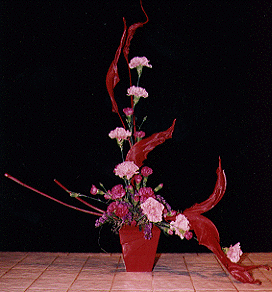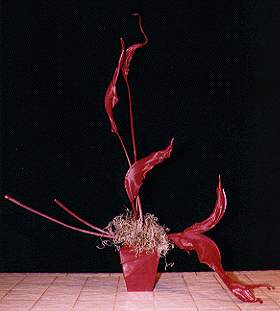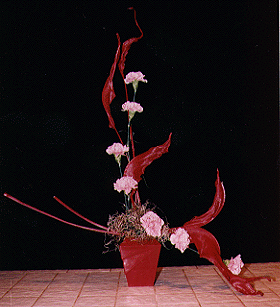|
Rittners School Of Floral Design
In Boston Presents....
 How To Make A Simple Contemporary Vase Arrangement How To Make A Simple Contemporary Vase Arrangement
Most American flower shops today are capable of doing both traditional as well as contemporary floral art. Traditional floral designing is characterized as having greater quantities of flowers, more foliage, etc. Contemporary floral art generally uses less materials, but makes greater use of space. Contemporary floral design tends to mix unusual combinations of things together. It has the feeling of Oriental style floral designing, yet it is distinctively Western.
This is a good example of a simple contemporary floral design. As you look at it you notice that the design doesn't use a great quantity of material, yet it is quite large. Although positive space is filled with the floral materials, there is a great deal of space in between the floral segments of the design. (Floral artists like to give these "voids" a fancy name. They call it "negative space." It sounds quite profound anyhow!!)
To make this design we have deliberately chosen materials that are both easy to get and to use. Try it! You'll find that you can create very distinctive floral designs using this style and approach, that will impress your friends & relatives. And best of all, they are quite easy to make!!!!
What You Will Need
Container
3/4 block of foam
7 Carnations
1/2 bunch of miniature carnations
A little statice
5 strelitzia leaves
Spanish moss
We start this design by placing our piece of foam into a container. The base that we are using is a plastic one that is relatively inexpensive. Note that at one time a plastic utility container was generally a very plain white, green or clear dish. Today, however, there are many inexpensive plastic containers that have very stylish shapes & come in a wide variety of colors.  If using plastic, be sure to weigh the base down to avoid a balance problem. If you are using a ceramic or other heavier base that is not an issue. If using plastic, be sure to weigh the base down to avoid a balance problem. If you are using a ceramic or other heavier base that is not an issue.
Let's start with some of our dried materials. The rather strange looking materials you see in the picture are dried strelitzia leaves. Yes that's right, they are strelitzia, otherwise known as "bird of paradise." (You should be able to get dried strelitzia leaves from your local florist.) Strelitzia or bird of paradise flower is the very popular exotic flower that looks something like a bird, (The flowers are orange with a touch of blue). Anyhow, they take the leaves, dry them, and sell them separately. The strelitzia leaves have an interesting texture & provide a very unusual parchment-like effect. These are dyed and sold in a wide variety of colors.
In our design today we have chosen some red violet leaves that go well with the color of the container. We have placed three of our dried strelitzia leaves into the center of the design, staggering the heights. Two additional strelitzia leaves are placed into the right side of the foam. These have been cut shorter, and the rest of their stems have been inserted into the left side of the foam. The design gives the illusion that each of the two bottom strelitzia leaves has been placed through the foam with the heads on the right, and the stems going out through the left.
Place spanish moss purchased from your local flower shop loosely around the base. The spanish moss covers the mechanics. We hold it in place with some small pieces of florist wire bent into U shapes.
 The dried materials created the overall form of the design. Now it's time to start filling in. Let's take some of our carnations, and create a gentle crescent as shown in the illustration at the left. Only seven flowers are needed, yet they are quite effective visually The dried materials created the overall form of the design. Now it's time to start filling in. Let's take some of our carnations, and create a gentle crescent as shown in the illustration at the left. Only seven flowers are needed, yet they are quite effective visually
This illustrates several key features of contemporary floral art. In this design we are mixing both live and dried materials. Contemporary floral design often combines unusual or different combinations of materials.
Also notice that we are mixing two lines here--the tipped triangle that is formed by the dried strelitzia leaves & the crescent formed by the carnations. This creates additional interest for the easy flow of the curving crescent is in marked contrast to the more formal linear triangular shape.
 The design is pretty but still rather sparse. So let's take some miniature carnations and fill in between the carnations. As we go down towards the base, particularly in the bottom focal area, we fill in with a few minis. This is important for it creates the visual weight that the design needs at the baseline. A few mini carnations are extended to the bottom left and right, creating a smaller triangle within the overall larger unit. The design is pretty but still rather sparse. So let's take some miniature carnations and fill in between the carnations. As we go down towards the base, particularly in the bottom focal area, we fill in with a few minis. This is important for it creates the visual weight that the design needs at the baseline. A few mini carnations are extended to the bottom left and right, creating a smaller triangle within the overall larger unit.
A few pieces of statice provide variety and contrast of texture down near the baseline of the design.
This is a design meant to be viewed on one side. It would be very effective in an entry hall, or on a side table. Although we used carnations in this example we could vary the mood and price of the design by substituting yarrow, roses, gerbera or stargazer lilies. In place of the miniature carnations, consider the use of button poms, starburst poms, dendrobium orchids, or sweetheart roses.
We hope that you really enjoyed this brief floral design lesson. At Rittners Floral School in Boston we provide floral design instruction that includes a wide range of different styles and techniques. Please come and take one of our hands-on workshop programs!!
Rittners Floral Education Center returns you to our Floral Education Center.
Your Webmaster is Dr. Steve Rittner, who may be reached at Stevrt@tiac.net.
All photographs and text on this page are Copyright - Rittners School,
and may not be reproduced, or used for any commercial purposes.
|